 On the block where I work, they’re putting the finishing touches on a new restaurant. It’s got black walls with slogans spelled out in brushed metal lettering, bright red furniture, and a gleaming stainless steel open kitchen. It looks modern and cool. So naturally, I was surprised when I saw the sign go up and discovered it was a Burger King.
On the block where I work, they’re putting the finishing touches on a new restaurant. It’s got black walls with slogans spelled out in brushed metal lettering, bright red furniture, and a gleaming stainless steel open kitchen. It looks modern and cool. So naturally, I was surprised when I saw the sign go up and discovered it was a Burger King.
Sort of. It’s actually a Whopper Bar, which is like Burger King’s cool younger brother. According to the official website, it’s a “premium dining experience,” and there are only three of them in the United States right now. (The Manhattan location will be the fourth.) When the New York Daily News reported on the Whopper Bar back in January, they made it sound like the whole appeal was the opportunity to buy a beer with your lunch. But in BK’s official press release, they claimed customization was the real attraction:
Sandwiches are built to order by an expert “WHOPPER®-ista” from the WHOPPER® Topper, a visible toppings theater that allows guests to choose from favorites like A.1.® Thick & Hearty steak sauce, smoked bacon, Angry onions and guacamole.
This isn’t your father’s Whopper!
Capitalizing on America’s favorite burger, the WHOPPER™ Bar is a completely new, enhanced spin-off concept of the traditional restaurant with a crisp, modern, bar-like look and feel that utilizes the WHOPPER® sandwich’s flame-broiling as inspiration. Crew uniforms will be transformed, emphasizing the red, black and gray color scheme of the bar setting, and boast a more contemporary cut that matches the look and feel of this bold new approach. Even the product packaging is all new. The sandwich will be served in an upgraded, carton-like box – a necessity when it comes to holding as many additional toppings as guests wish to add.
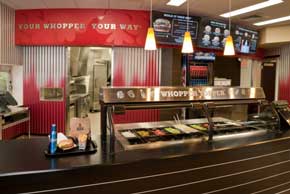 Okay, on second thought, it is actually your father’s Whopper. It’s just that every other aspect of the restaurant besides the burger has changed. (Also, side note: isn’t there a verb tense agreement error in the second sentence? Future tense (will be transformed) vs. present tense (boast)?)
Okay, on second thought, it is actually your father’s Whopper. It’s just that every other aspect of the restaurant besides the burger has changed. (Also, side note: isn’t there a verb tense agreement error in the second sentence? Future tense (will be transformed) vs. present tense (boast)?)
Anyway, let’s see if we can figure out what’s going on with this Whopper Bar.
Burger King, as it turns out, has been doing meh business for most of our lifetimes. After a particularly rough patch in the mid-80s, it was bought by a British company, Grand Metropolitan. Its new owners drove the company further into the ground, and it was put up for sale in 2000. At this point, Burger King was losing a so much money that the Brits gave it away for $1.5 billion, significantly less than the asking price.
So now it’s 2002, and Burger King’s new owners are looking to beef up sales in an attempt to ketchup to McDonald’s. According to this revealing article in The Wall Street Journal, their strategy was to zero in on the “super fans,” 18-to-35-year-old dudes who made up half of the chain’s business:
Burger King tried to distinguish itself from rivals by addressing young men, in particular, like “the cool uncle who tells you how it is,” says John Schaufelberger, Burger King’s senior vice president of global product marketing and innovation.
 I wonder if they gave John the job because his name contains the word “burger”?
I wonder if they gave John the job because his name contains the word “burger”?
Think about all those hipsteriffic commercials with The King, and compare him to Kid Vid. Burger King basically made a decision to sacrifice its appeal to kids and families and build its loyalty with the bros. From the article:
“We had multiple marketing meetings where we bemoaned that our kids’ meal sales had dropped dramatically, and that we didn’t have a dessert program, and the company said, ‘This is the way we’re doing it,'” says Julian Josephson, who owns 40 Burger Kings in the West and Southwest.
And for a while, the strategy worked. BK had 20 consecutive quarters of growth. Even considering how badly they were doing in 2000, that’s still impressive.
Then came the Recession. It was a tough time for everyone, but especially 18-to-35-year-old males. (According to one study, 82% of the jobs lost in 2008 were lost by men.) BK’s core customers just didn’t have Whopper money anymore, and its sales fell 4.6% in the third quarter of 2009 alone. During the same period, McDonald’s increased its sales by 2.5%. In other words, people were turning to McDonald’s as a necessity, but giving up Burger King as a luxury.
Meanwhile, one of the hottest food industry trends over the past decade is “fast casual.” These places fill the gap between Burger King and an actual sit-down tip-your-waitress restaurant. Think Panda Express, Panera, and especially Chipotle. I’ll let Wikipedia explain:
Counter service accompanied by handmade food (often visible via an open kitchen) is typical. Alcohol may be served. Dishes like steak may be offered. The menu is usually limited to an extended over-counter display, and options in the way the food is prepared are emphasized. Health-conscious items have a larger-than-normal portion of the menu. Some restaurants may emphasize high quality ingredients like free-range chicken and freshly made salsas. Overall, the quality of the food is presented as much higher than conventional fast food.
As it turns out, all those young men who forsook Burger King haven’t necessarily been eating in all the time. From the Journal again:
People 18 to 34 cut their consumption of fast-food meals from November 2006 to November 2009 while increasing the number of meals they ate at fast-casual chains, says Bonnie Riggs, restaurant industry analyst at market-research firm NPD Group.
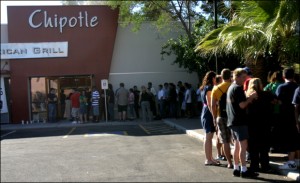 Since fast casual is usually more expensive than fast food, there’s clearly more than the recession going on here. A lot of it is health-related: in this post-Super Size Me world, people are more aware than ever that fast food is a one way ticket to Diabetesville (Population: you and Wilfred Brimley). And even though the burritos at Chipotle are ridiculously unhealthy, people feel like they’re eating smarter, because there’s free range chicken and sexy modern industrial decor.
Since fast casual is usually more expensive than fast food, there’s clearly more than the recession going on here. A lot of it is health-related: in this post-Super Size Me world, people are more aware than ever that fast food is a one way ticket to Diabetesville (Population: you and Wilfred Brimley). And even though the burritos at Chipotle are ridiculously unhealthy, people feel like they’re eating smarter, because there’s free range chicken and sexy modern industrial decor.
 If you want to see where Burger King’s super fans are defecting to, visit a place called Chop’t next to my office. It’s a funky salad joint with items like heirloom tomatoes, Wild Planet tuna, and goat cheese. The earth-toned walls are covered with sans-serif messages about how environmentally-friendly and healthy their ingredients are. Sticking to the fast casual playbook, your salad is prepared right in front of you, by a guy with a special curved blade that looks vaguely Klingon. This place is always mobbed. At lunchtime, the line stretches around the block. And the line is almost entirely 18-to-35-year-olds, who would probably feel a little ashamed slinking back to the office with a Burger King bag.
If you want to see where Burger King’s super fans are defecting to, visit a place called Chop’t next to my office. It’s a funky salad joint with items like heirloom tomatoes, Wild Planet tuna, and goat cheese. The earth-toned walls are covered with sans-serif messages about how environmentally-friendly and healthy their ingredients are. Sticking to the fast casual playbook, your salad is prepared right in front of you, by a guy with a special curved blade that looks vaguely Klingon. This place is always mobbed. At lunchtime, the line stretches around the block. And the line is almost entirely 18-to-35-year-olds, who would probably feel a little ashamed slinking back to the office with a Burger King bag.
The fast casual craze has not gone unnoticed by the old school fast food giants. When I started Googling for this article, I discovered that Wendy’s is launching a premium salad bar this week. CMO Ken Calwell makes no secret about their inspiration:
In New York, there’s a salad restaurant called Chop’t, and you will pay anywhere from $7 to $8 to $9 for a salad there. I went in there to get a salad last week and paid $8.85. I waited in line for 27 minutes at lunch, it was a great salad, but I paid more than $8—almost $9—for it. What I’m trying to do at Wendy’s is give you great salads that have those high integrity and high quality ingredients that you can get for $5.99 at every Wendy’s across the country consistently and you can get it in a minute.
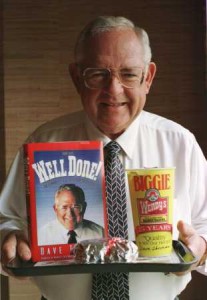 But here’s the problem with that plan: Wendy’s is still Wendy’s. Everyone knows Wendy’s is a fast food place. Everyone remembers kindly old Dave Thomas biting into a strangely square double cheeseburger. Brands do not turn on a dime–even if Wendy’s served the exact same heirloom tomatoes as Chop’t, cut with the exact same Klingon weapon, 18-to-35-year-olds still wouldn’t think of the place as healthy or cool. They’d think of the place as trying to copy Chop’t.
But here’s the problem with that plan: Wendy’s is still Wendy’s. Everyone knows Wendy’s is a fast food place. Everyone remembers kindly old Dave Thomas biting into a strangely square double cheeseburger. Brands do not turn on a dime–even if Wendy’s served the exact same heirloom tomatoes as Chop’t, cut with the exact same Klingon weapon, 18-to-35-year-olds still wouldn’t think of the place as healthy or cool. They’d think of the place as trying to copy Chop’t.
Did you know that for many years, McDonald’s was the majority owner of Chipotle? No you didn’t. They didn’t want you to know.
Here’s another piece of fast casual news this week: two former McDonald’s executives are opening a new eco-friendly chain, with the following overkill features:
- Grass covered parking lots
- Rooftop herb gardens
- Biodegradable cutlery
- Electric car powered home delivery
- Healthier menu items such as steel cut oats, pita pockets, homemade soups and kebabs.
Meanwhile, poor old McDonald’s is desperately trying to look like a fast casual restaurant:
Building upon their design success in France and the United Kingdom, the new McDonald’s look is sleek and sophisticated, with modern, movable furniture, subdued indirect lighting, outlets for laptop connections, free Wi-Fi and wide-screen plasma televisions.

The new McDonald's, believe it or not.
This is a strange development. One thinks of fast food restaurants competing on the basis of price. Five dollar foot-longs! Dollar menus! A bowl of melted cheese for only 17 cents! (In Demolition Man‘s future L.A., Sandra Bullock explains, “Taco Bell was the only restaurant to survive the Franchise Wars. Now all restaurants are Taco Bell.”)
But today, fast food places are seeing their business shaved away by slightly more upscale rivals. Being perceived as ridiculously cheap is a liability with this demo. So to compete, restaurants have to add a little class… without actually raising prices. Perfect example: a few years back, Carls Jr. introduced the Six Dollar Burger. The cost? $3.95. It’s all about creating an impression of quality and an atmosphere of sophistication, without actually changing the menu too much.
And that brings us back to the Whopper Bar. Burger King spent years building its business on bros, who are now defecting to fast casual. So instead of serving the burgers here…

… they’re going to try serving them here:
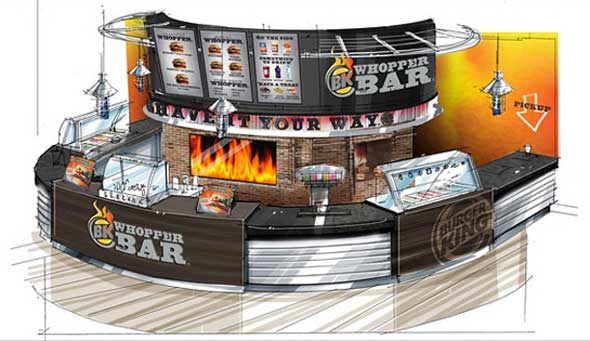
Keep in mind, most of the menu will be the same. There will be a few fancy Whopper variations at the Bar that you won’t find at a regular old BK. But basically, it’s the same stuff.
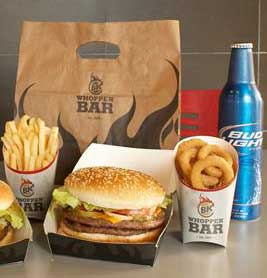
Yes, you can get a beer there.
And that’s why I think this Whopper Bar thing isn’t gonna fly. You see, Burger King obviously didn’t read Wikipedia, and they missed a core aspect of the fast casual thing: the food has got to at least seem healthy. Natural. Wholesome. The Whopper Bar does not seem wholesome. It’s got “Whopper” right in the name. People know that the Whopper is bad for you, and there’s no way around that. The people in line for their St. Tropez salad at Chop’t are not going to start buying cheeseburgers for lunch just because the restaurant looks cool. (Of course, I wouldn’t be surprised to hear that the St. Tropez salad has just as many calories as the Whopper. But it’s all locally-grown organic produce! Swoon!) Burger King seems to think that people are going to Chipotle just because it has cool lighting. But they’re actually going, at least in part, because it seems healthier than the Taco Bell across the street. The Whopper Bar is basically a fancy new wrapper for the same old burger… and nobody goes to a restaurant just for the wrapper.
Fascinating. And now I’m hungry.
I haven’t yet put a checkmark in today’s “uncalled-for feminism column,” so let’s make this all about gender.
In my mind, Burger King has always been associated with paper crown birthday parties and screaming children in ball pits. Burger King recently found out its audience is actually lower-, working-, and poorer middle-class 18-34 yr-old men who probably don’t care much about their weight. (After all, they’re eating Whoppers.) So they doubled down. Instead of going in the direction of Chipotle or Chop’t (which, in my mind, read professional/metrosexual/liberal/enviromentally-friendly/women in flip-flops/how dare Al Gore know what arugula is?), Burger King went more in the direction of Axe body spray. Keep the Whopper and make everything else Manly! Make the colors black and red–red and black are Manly colors! Put flames on everything! Onions on their own are too girly; let’s do “angry onions” instead! Real men like bars–let’s make it look kind of like a bar! Stainless steel reminds people of guns and motorcycles! YEAAAHHHH TESTOSTERONE BITCHES!!!
If they stick some hot female servers in there, we may have a winner. …Maybe.
Is there any story behind that picture of people lining up to get inside a Chipolte? Something along the lines of a free burrito or something? If not, I just find that baffling.
Then again, I find this whole fast food re-branding and fast casual stuff utterly bizarre. The only explanation for it that I can find is, to quote H.L. Mencken (possibly apocryphally, and more than likely misworded), nobody ever went broke underestimating the intelligence of the American public.
nobody goes to a restaurant just for the wrapper.
well ACTUALLY…
There was a study done in… hmmm, 2006? 2005? I’m going to have to dig for the citation, but the scientists sampled a large group of American children 12 and under, and discovered that the kids would, by a large majority, express a preference for food in a McDonald’s wrapper, even if the food isn’t actually from McDonald’s – heck, even if the food can’t even be ordered at McDonald’s. In other words, these kids thought they liked carrot sticks better when they were served in McDonald’s packaging, even though Mickey D’s doesn’t sell carrot sticks.
Scary stuff. At some point, I’m sure, our rational brains can overcome this social-programming-like effect, but it really makes you wonder what’s going on in your head before it even bubbles up to the level where you acknowledge it…
Just sayin’.
This Whopper Bar thing? It looks stupid.
@mlawski – Yes, I think that designed-by-Maxim look isn’t an accident. Burger King’s strategy of catering to young men may have backfired, but it’s not backing down. It’s DOUBLING down, trying to win back the young men with a Tucker Maxish burger temple. Nevertheless, I don’t think the strategy is gonna work. The crowds at Chipotle and Chop’d aren’t all women – men love those places too. I think as much as young men love metal accents, they ARE worried about their health more and more. Not ALL of them, but enough to make the Whopper Bar a dubious prospect. Burger King can’t even brag about how fresh its Whopper Bar ingredients are, because it’s the SAME ingredients. It’s NOT hormone-free beef. The bread is NOT baked on the premises. (Some of the toppings are new, but that’s, quite literally, weak sauce.)
@Chris – Okay, I cheated a little. The photo of the Chipotle was from a special free food giveaway promotion. I just wanted to illustrate “Chipotle is popular,” but now I feel a little sneaky.
One of the things I find absolutely amazing about the whole fast-casual business is that there’s also a health-choice involved.
I work at a Mexican fast-casual place which I would compare to Chipotle, but with an expanded menu (which is maybe a dollar or two more expensive) and with all food cooked and prepared in-house (which is unheard of for me in the fast-food or fast-casual industry). Also, it has a bar, which does wonders for profits.
Additionally, I’ve held a job at a Pita Pit and at local coffeehouse that could easily be franchised with sufficient funding.
Anyways, the interesting thing about all of these kinds of places, is that there is an active choice in how healthy you will be. Just like a Subway, you can choose to eat right or you can choose to get a double-meat Italian heart attack on bread that might actually be less healthy for you than smothered and covered hash-browns from Waffle House.
There’s something to be said for a restaurant that offers its clientèle the choice to eat healthy (or appear to eat healthy) or the choice to indulge in a 1200 Calorie deep fried meal covered in cheese. The most interesting aspect to this is that the customers range from the middle aged man who spends every minute after noon drinking, to the weight/health conscious American female, to the morbidly obese males in the 18-35 demographic, to just regular teenage kids coming in for a cheap meal (there were also similar varieties in the coffee-shop and the Pita Pit, but neither had such diversity in their customers and neither were anywhere near as successful as my current employer).
My point is, I think that the healthy eating isn’t the key to the success of fast-casual, but just a part of the larger picture. I think that giving customers the choice to eat healthy (or appear to eat healthy) is a large factor in attracting a diverse customer-base without a majority demographic, and thereby becoming more successful. Without that choice to eat healthy (whether it’s a real choice or an false appearance), I somehow doubt that the Whopper Bar will succeed nationwide, but it might succeed in certain niches like in fast-food loving Texas (in fact most of the southeast United States too).
I think that Belinkie is dead on about the branding problem. I’m looking at that concept art up there, and thinking “No.” Then I try to picture it with just a *tiny* change – what if rather than “Whopper Bar,” it was called “Burger Bar,” and the BK logo was nowhere to be seen? Yeah, I could see myself trying that out.
Regarding health food: when I go to Chipotle, which is really pretty often, I get a vegetarian burrito bowl with all the salsas, sour cream, and lettuce. This works out to just shy of 600 calories: not grueling rations, to be sure, but nothing to be ashamed of as long as you ignore the 2.4 grams of sodium. (Every so often, I still opt for the carnitas, which pushes things into the shame zone real quick. But these occasions are rare.) What’s interesting to me is this: I feel perfectly happy about getting my vegetarian non-burrito. It seems like a smart thing to do, health-wise, and it still tastes delicious. Because I have already been convinced that eating at Chipotle is healthy (as Matt suggests), ordering as healthily as possible is just another part of the Chipotle experience. It doesn’t require an exercise of willpower on my part, and therefore doesn’t feel like “dieting,” in the mortification-of-the-flesh sense that the word usually implies.
When I go to a normal fast food place, though, it’s a different story. It is usually possible to eat healthy at these places, for a given value of healthy. Get a grilled chicken sandwich, or something. Hell, a Big Mac with a diet coke and no fries is only 572 calories. But something about counting calories at McDonalds feels faintly ridiculous. “Who are you trying to fool, here?” says a little voice in my head. “Come on, don’t be That Guy. Obviously if you cared about your health, you wouldn’t be eating at McDonalds. Quit assing around and order the Angus 1/3 lb. Bacon Cheeseburger with extra hog tallow.”
Granted, the fact that I apparently need to give myself permission not to eat like a moron points to some kind of underlying psychological hang-up. I still think that a restaurant’s basic branding can have a powerful effect on its customers’ decisions.
@Stokes: What a great observation. It’s like how I always order turkey sandwiches on whole wheat (the healthiest thing on the menu) at Subway, so I can be like Jared. Then again, I also have them put on delicious and oh-so-fattening chipotle mayonnaise, so maybe not…
@mlawski
You’re dead-on for the gender focus of Burger King. The blog Burger Buisness has been talking about this issue for awhile, since the franchisees of BK are in near revolt. Corporate BK doubled down on the ultra-male demographic, but it completely turned itself off to those outside that demographic.
On top of this, which isn’t mentioned in the original article at all but I’m sure is having an effect, is that the 18-35 male demo doesn’t even need BK or other fast food anymore if they want a burger. If they have the money/location to go to a Chop’t or a Chipotle, then they certainly have the money (and likely are in the right location) for a fast casual burger place like 5 Guys or Smashburger.
Perhaps this is an unfortunate instance of a creative young marketing genius trying to create a market niche that doesn’t exist. If I want cheap, I go grab McDonalds in a crappy styrofoam box and I am all too aware of its negative health effects. I wouldn’t take a date to a metallic-stlyed burger bar. If I’m health conscious, I don’t go to anywhere branded with the word “Whopper.” If I want two metric tons of greasy goodness, I go to Chipotle, and my girlfriend gets a vegetarian burrito that probably has more calories than my dairy-products-only grilled chicken tacos. When would I ever go to the Whopper Bar?
I thought I’d throw in an article about who really prefers the color red, men or women. http://people.howstuffworks.com/gender-color.htm
There’s something more inviting about the warm color palate that the Whopper Bar and Chipotle are using. It’s not the primary color commercialism of the fast food places. It’s not the green, environmentally friendly, nature-inspired color palate of Chop’t. From a purely aesthetic standpoint, this is ruined for me by the metal. Is that the “casual” element missing from upscale eateries? It seems to be a garring decor choice that speaks to the underlaying falsehood. The “appears to be” rather than the “is”.
Am I the only one who sees that Whopper Bar and thinks of the Cafe in 2015 in Back to the Future 2? Next step – hover boards that inexplicably don’t work on water!
I think the sentence IS grammatical, because the “will” in the first part can also apply to the word “boast.” A simplified example would be: “You will trip on my roller skates and fall down.” You don’t need to repeat the “will” for “fall down” even though it too, is in the future.
I think it’s still wrong. The problem is in the shift from passive to active voice: this way it’s written assumes that we read “will be transformed” as “will | be transformed,” implying a later “(will) | boast,” but I tend to read it as “will be | transformed,” instead, which leaves us down the road with the nonsensical “(will be) | boast.” The simplified example “You will be dressed in rollerskates and fall down” is intelligible but awkward (to my ear, anyway), and if you pick the right verb it can go totally off the rails. “You will be asked to wear rollerskates and fall down.” Are you being asked to fall down? Inquiring minds want to know!
Even if it’s not strictly wrong, it is bad, execrably, deplorably bad. Grammar that makes the reader stop mid-paragraph and think “wait, what?!” IS a mistake, whether it’s technically correct or not. And honestly, the new modern cut of the uniforms is part of the redesign to begin with, so why give it a verb of its own? “Crew uniforms will be transformed, emphasizing the red, black and gray color scheme of the bar setting, and a more contemporary cut that matches the look and feel of this bold new approach.” The uniforms are transformed, the color scheme and the cut are emphasized, and the sentence is no longer painful to read.
McDonald’s and Burger King both seem stuck with this all-plastic-all-the-time decor that probably looked cool and futuristic in the 1960s, but now looks cheap, like something in a bus station. So don’t underestimate the effects of just redecorating the restaurants in potentially attracting more customers.
The food is a bigger problem, and the only solution I can think of for the chains is to arrange to kill Michael Pollan. Its not just the calories (calorie wise, eating at these places is fine as long as its our only meal of the day), its the processed, industrialized nature of the food they serve. But to serve more, well, organic food would drive up their costs. Maybe the executives should talk to some of the guys who operate halal carts and see if they can get any ideas.
@Jon Eric – McDonalds do serve carrot sticks as part of the Happy Meal in the UK, and I’ll bet France, where this rebranding has happened. The clientèle hasn’t really changed, they just sit in more stylish places wit wifi that about one guy in the whole city uses.
Stokes, your new sentence was much more painful for me to read. The original sentence I parsed immediately, while yours made me stop and say, “Wait, what?”
I think it’s your improper use of commas, or the fact that you said you were going to give the cut a verb of its own and then didn’t. On the first point, given your lack of a serial comma in the colors, the comma before the last and has the same function as it does in the original sentence: marking the end of the “emphasizing” clause. Thus taking out the additional clause, the original reads:
will be transformed . . . and boast . . .
and yours reads:
will be transformed . . . and a more contemporary cut that matches . . ..
Notice the lack of a verb in the second part.
There is also a large difference between something being grammatically incorrect and just awkward
Cat, the article on pink is for girls with its “Just so” story might have some weight for all cultures if A. it tested more than 2 cultures, B. it tested at least one group of people never exposed to the idea that pink is for girls, or C. the colors didn’t used to be assigned to opposite genders http://en.wikipedia.org/wiki/Pink#Pink_in_gender.
I think the choice thing is something that needs to be emphasized again. The *option* to be healthy, eco-friendly, etc. When presented with it, consumers go for it, supposedly. But I’d argue they simply wish to put forth a *pretense* of doing so and don’t actually follow through. Classic example: In line at Subway, I heard a person say to their companion, “I’m glad we came here, it’s healthier.” Then, a few minutes later, “Now, should I be good, or get what I want?” And they proceeded to get a very, very meaty sammich with extra cheese and mayo. They were psyching themselves into believing they were being healthy- and justifying what they knew was a bad choice to their companion. I think people do that sort of thing all the time. As has been pointed out, it’s organic, so it *must* be healthier, right? Even though they know perfectly well that it’s not. The element of choice is what BK is literally banking on, that since the stuff is Subway/Pita Pit- styled, people will want to flock in because the fact that they bother to choose to go somewhere they can choose directly what goes *into their meal* gives an impression of making good (read: healthier) choices by default. And we want everybody *else* to think we’re healthier than that d-bag going into the McDondald’s across the street, *we* aren’t going to die of a heart attack at forty-two, *we* aren’t killing the enviornment and encouraging animal cruelty or labor-worker abuse! Pita Pit advertises itself as lighter eating, but it’s not *actually* fooling anybody- at least, I’d hope so.
And maybe I watch Gordon Ramsey’s various shows too much, but I also think the design aesthetic is pseudo-modern-bistro- it looks like the kind of place he’d operate or would turn one of the failing restaurants he helps into after attacking the decour.
@cat: But I wear pink all the time. Does that make me an anti-feminine conformist? ;p
Oh, and this:
http://www.collegehumor.com/video:1935115
@Aaron and @Gab My point was not to agree with the article but to disagree with the assumption that “red and black are Manly colors”. There’s some confusion. I think the article reflects that no one can really make definitive statements at this point.
@cat- Sorry, realized that and was trying to be funny. I tend to fail when I do it over the internet, though… Mea culpa.
Hmph. There was a chain back in the long-ago days called Burger Chef (anyone else remember “Burger Chef and Jeff”?) and they had a burger bar too. It was actually a very good burger bar and you could order burgers plain for cheap, or with stuff already on and then doctor it up more (which is what I did, because the sauce was yummy).
But anyway, I don’t see any more of those Burger Chef restaurants around anywhere, and my guess is that this won’t make much difference for Burger King, either. Years ago I went there by choice; now I only go if there’s absolutely no other way to get something quick for lunch. The simple reason is that the food doesn’t taste good anymore. They’ve changed it, cheapened it or whatever, and now it’s actually pretty nasty. They used to have the best fries ever and now they’re barely edible. They really do need to change the core concept of the business if they want to stage a comeback. Stage dressing won’t help much, if at all.
@Gab – You’re totally right about savvy restaurants offering healthy choices and healthy atmosphere, but also allowing people to eat the same unhealthy stuff they love. This is called the “Halo Effect.” You use Subway as a good example. Coincidentally, there was a study that asked people who had just eaten at Subway to estimate how many calories their meal contained. The Subway eaters consistently underestimated their calories, by more than people who ate at McDonalds. Here’s the link:
http://www.reuters.com/article/idUSCOL46140720070914
Key sentence: “For a meal at either restaurant containing 1,000 calories, people would estimate it to contain 744 calories if they’d eaten at McDonalds and 585 calories if they’d dined at Subway.”
But Gab, this is where The Whopper Bar really drops the ball. It’s totally unlike Subway or Pita Pit. The Whopper Bar doesn’t SEEM healthy. It doesn’t claim to offer fresh, all-natural ingredients. It doesn’t brag about its salad bar. It’s a burger bar. If anything, they’re probably going to butter up to the guys (no pun intended) by selling it as the manly, decadent alternative to your girlfriend’s wimpy health food.
The Whopper Bar has an ANTI Halo Effect. A Pitchfork Effect. If nobody has coined that before, I just did. Trademark!
@Belinkie: Hm, I guess 1) I had more faith in people and assumed they weren’t *actually* kidding themselves. Crap. And 2) I didn’t realize the choices were being presented as the “manly” ones. Pitchfork Effect? Made of awesome! I guffawed quite hard at that one. It’s perfect, it matches the flames they already have on their packaging and such. I’m imagining the *new* mascot, now.
@zenspinner: Burger Chef was bought by Hardee’s.
@Belinkie: Fascinating! In fact, we at Chop’t, spend much of our time discussing these exact things, but your article; AND the comments, have been incredibly illuminating and really very accurate(from where we sit) and educational, especially from the customer’s/commenter’s point-of-view. I would love to discuss your opinions in more detail when you/if have a chance. Thanks, Colin, Chop’t Co-Founder